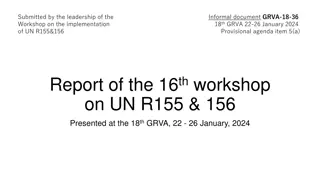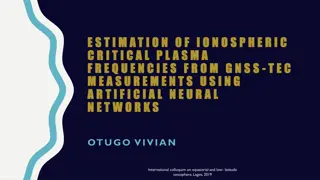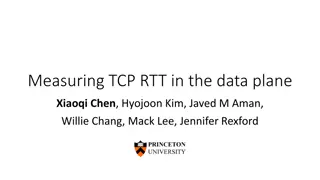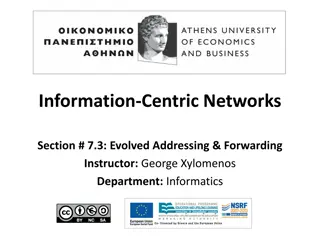Understanding Static GNSS Techniques and Products for Geospatial Applications
This educational material provides insights into static GNSS techniques, products, and their societal benefits. It covers topics such as distinguishing static GNSS techniques, understanding different products, and the capabilities of static GNSS stations. The content explores the Network of the Amer
3 views • 20 slides
Asia-Pacific Location-based Services Market
Asia-Pacific Location-based Services Market by Component, Technology (GNSS, GPS), Application (Navigation, Mapping & GIS), Location Type, End-use Industry (Transportation & Logistics, Retail & E-commerce), and Geography -Forecast to 2031
1 views • 5 slides
Workshop Report on Implementation of UN Regulations R155 & R156
The report presents key discussions from the 16th workshop on UN Regulations R155 & R156, covering topics such as GNSS spoofing, reporting provisions, software updates, and recertification processes for CSMS/SUMS. It highlights the need for risk assessment, annual reporting, software obligations, an
0 views • 11 slides
Recent Developments in GAMIT/GLOBK for GNSS Processing
Significant updates and future developments in GAMIT/GLOBK for GNSS processing include processing of multiple constellations independently, transition to secure HTTP for code distribution, addition of azimuth field for station alignment, and regular updates schedule. Higher-order ionosphere and rapi
0 views • 10 slides
Understanding the Importance of Geoid Models Using GNSS Technology
Explore the significance of geoid models in surveying to determine orthometric heights, monitor sea level changes, and establish stable datum reference frames. The challenges, solutions, and recommendations for geoid development are discussed in the context of Majuro, RMI. Various aspects like geoid
1 views • 14 slides
Standard Data File Formats for Geospatial Instruments
Understanding the importance of standard file formats for GNSS, total stations, automatic levels, and relative gravimeters to facilitate data exchange, processing, and preservation in the geospatial industry. Exploring the significance of RINEX and other XML-based formats, along with examples and th
2 views • 30 slides
Understanding Global Navigation Satellite Systems (GNSS) in Geospatial Data for Public Health
Explore the key terms such as accuracy, GLONASS, GPS, precision, scale, and more in this session on GNSS technology. Understand how GNSS works, the constellation of satellites involved, and the different satellite navigation systems like GPS, GLONASS, BeiDou, and Galileo that provide autonomous geo-
6 views • 23 slides
Location-Based Services Market: Emerging Technologies and Their Applications
Location-based Services Market by Component, Technology (GNSS, GPS), Application (Navigation, Tracking), Location Type, End-use Industry (Government and Public Sector, Transportation & Logistics, Smart Cities), and Geography - Global Forecast to 2031
0 views • 4 slides
Estimation of Ionospheric Critical Plasma Frequencies Using GNSS Measurements
This research focuses on estimating the critical plasma frequency of the ionosphere, specifically the F2 layer (f0F2), using GNSS measurements. The study reviews past work on ionospheric modeling, discusses neural network training inputs, and presents a single station neural network model (NNT2F2).
0 views • 26 slides
Enhancing Secure Telephone Identity and Caller Authentication
The STIR Working Group aims to address the issues surrounding the reliability of caller identities in telecommunication networks. By specifying internet-based mechanisms for verifying the authorization of calling parties, STIR seeks to combat threats like caller ID spoofing and unauthorized use of t
0 views • 11 slides
Understanding Enterprise Email Spam Prevention Techniques
Learn about the key strategies used by enterprises to combat email spam, including spam filters, SPF records, DMARC, DKIM, whitelisting, and SCL ratings. Discover how these tools work together to protect against spam, spoofing, and phishing attempts.
0 views • 8 slides
European Deep Space Surveillance and Tracking Collaboration
EU Space Surveillance and Tracking program involves five European nations collaborating to assess and reduce risks to European spacecraft, provide early warnings for re-entries and space debris, and prevent space debris proliferation. Available deep space sensors, such as optical telescopes, are uti
1 views • 8 slides
SHAKEN and STIRed: Current State of Anti-Spoofing and Robocall Mitigation
Exploring the challenges and efforts in combatting robocalls and caller spoofing in the telecommunications industry, focusing on restoring trust in voice networks through initiatives like SHAKEN (Secure Handling of Asserted information using toKENs) and STIR (Secure Telephone Identity Revisited). Th
0 views • 22 slides
Understanding GNSS Data Processing with RINEX Formats
Explore the journey of GNSS data from receiver to processing input, focusing on the motivation behind the Receiver INdependent EXchange (RINEX) format and the evolution from RINEX 2 to RINEX 3. Learn about raw data formats, RINEX file conventions, and the significance of RINEX 2 data format in GPS o
1 views • 15 slides
Enhancing Geoscience Field Courses with High-Precision GNSS Teaching Resources
Explore the benefits and challenges of integrating high-precision GNSS tools in field courses for geoscience students. Discover how students can develop valuable skills, apply GNSS surveys to societal issues, and tackle geologic research questions. Uncover strategies to overcome barriers and motivat
0 views • 8 slides
High-Tech Survey Methods for Continuous Cadastral Map Generation
Generation of cadastral maps through advanced survey techniques using ortho-images, DGPS/GNSS, and ETS. The process involves obtaining boundary vectors from ortho-images, surveying obscured areas with DGPS/GNSS and ETS, and integrating datasets in a GIS environment. The objective is to create contin
0 views • 14 slides
GNSS Ionospheric Study in Korea: Insights and Findings
Explore the status of GNSS ionospheric study in Korea, including details on Korea's GPS permanent network, IGS, KASI Global Data Center, TEC mapping, and ionospheric tomography. Discover how ground-based GPS data is used to study ionospheric electron densities and monitor ionospheric storms in Korea
0 views • 15 slides
Understanding Security Threats and Vulnerabilities in Computer Systems
In computer security, threats exploit vulnerabilities to breach security and cause harm. Vulnerabilities arise from system weaknesses, attacker access, and capability. Threats include spoofing, data tampering, repudiation, information disclosure, denial of service, and elevation of privilege. Catego
0 views • 13 slides
Understanding REC and SEC Coordinates in Geodesy
Geodesist Boris Kanazir and NSRS Modernization Manager Dru Smith delve into the definitions, differences, and purposes of Reference Epoch Coordinates (RECs) and Survey Epoch Coordinates (SECs) at the 2021 Geospatial Summit. OPUS coordinates, SEC computation by NGS every four weeks, REC re-computatio
0 views • 17 slides
Understanding GPS Data Processing and RINEX Formats
Learn about the process of transferring GPS data from receivers to processing input, the importance of RINEX formats for universal data exchange, different raw data formats, motivation behind RINEX development, and details about RINEX versions. Explore RINEX 2 data format, its file naming convention
0 views • 13 slides
GNSS 2018 Program and Data Management Guide
Detailed guide on managing GNSS data for the year 2018, covering essential programs, utilities, file structures, and data sources. It includes information on arranging ephemerides, preparing site folders, finding GNSS data, GPS measurements archives, and relevant links for data retrieval.
0 views • 51 slides
Understanding TCP Round-Trip Time Measurement
This presentation delves into the importance of measuring TCP round-trip time in the data plane, highlighting key reasons such as security against BGP hijacks and IP spoofing, performance enhancements, and improving user Quality of Experience. It explores monitoring at a vantage point, TCP sequence
0 views • 12 slides
GNSS Application in Pedestrian Navigation for Indoor and Outdoor Environments
Communication forms and visual aids play a crucial role in supporting pedestrian wayfinding. Different methods such as maps, floor plans, verbal and textual guidance, images, videos, and 3D presentations are utilized to enhance navigation experiences for users. The use of Location Based Services and
0 views • 19 slides
Financial Management and Cybersecurity: Essential Tips for Treasurers
A comprehensive guide covering topics such as budget development, treasurer's role responsibilities, and cybersecurity basics for treasurers. Learn about financial sustainability, board commitments, and protecting against cybersecurity threats like ransomware and spoofing scams. These insights aim t
0 views • 13 slides
Understanding Network Security Vulnerabilities and Attacks
Explore the world of network security vulnerabilities and attacks, including Denial-of-Service (DoS) and Distributed-Denial-of-Service (D-DoS), security flaws in the TCP/IP protocol suite, ICMP attacks, routing attacks, and TCP attacks. Learn about common security vulnerabilities such as address spo
0 views • 36 slides
Understanding Cybercrime: Types, Signs, and Prevention
Cybercrime involves various criminal activities targeting computers and networks, aiming to generate profit or cause harm. Types include website spoofing, ransomware, malware, IoT hacking, identity theft, and online scams. Signs of identity theft can manifest in credit, tax, child, medical, and crim
0 views • 6 slides
Understanding Cyber Threats in Today's Digital Landscape
Cyberspace is a vast realm encompassing the Internet, where we engage in various activities ranging from communication to entertainment. With the majority of children exposed to the online world, cybersecurity awareness is crucial to tackle the rising cyber threats. These threats include job frauds,
0 views • 33 slides
Evolved Addressing and Forwarding in Information-Centric Networks
The content discusses Evolved Addressing and Forwarding in Information-Centric Networks, focusing on an accountable Internet protocol (AIP) that addresses vulnerabilities at the IP level, such as source spoofing, DoS attacks, and route hijacking. AIP utilizes a hierarchy of self-certifying addresses
0 views • 16 slides
Implementation of Cornell Ionospheric Scintillation Model in Spirent GNSS Simulator
Researchers from the University of Nottingham and Spirent Communications collaborated to implement the Cornell Ionospheric Scintillation Model into the Spirent GNSS Simulator. The study focuses on the diffractive effects of ionospheric scintillation on GNSS signals, examining small-scale plasma irre
0 views • 24 slides
Stanford GPS/GNSS Matlab Platform Overview
Stanford GPS/GNSS Matlab Platform (SGMP) is an integrated research platform developed at Stanford University for GPS research activities. The platform provides tools for utilizing GPS/GNSS measurements in various formats, converting positioning databases, simulation capabilities, and user interfaces
0 views • 21 slides
Developing Attack Defense Ideas in Ad Hoc Wireless Networks
This research delves into the challenges and security threats faced by ad hoc wireless networks, particularly in the context of connected vehicles. It explores various attacks such as distributed denial-of-service, spoofing, replay, and more, and aims to measure the impact of implementing security m
0 views • 30 slides
Regulatory Aspects of CPND, CLI, and OI in ITU Workshop on Caller ID Spoofing
The ITU Workshop on Caller ID Spoofing in Geneva addressed the regulatory aspects of Calling Party Number Delivery (CPND), Calling Line Identification (CLI), and Origin Identification (OI) in the context of the International Telecommunications Regulations (ITRs). Divergent views were discussed regar
0 views • 12 slides
Advanced AI Facial Recognition System with Turnstile Features
A comprehensive overview of the advanced AI facial recognition system - AIFACE-MARS, showcasing its unique features such as visible light facial recognition, anti-spoofing algorithms, multiple verification methods, hardware specifications, and integrated one-way bridge tripod turnstile features. The
0 views • 9 slides
Enhancing Wi-Fi Authentication Using Channel State Information
This research discusses enhancing Wi-Fi authentication by actively eliciting channel state information (CSI) to detect spoofing attacks. The challenge lies in obtaining the legitimate user's CSI and comparing it in real-time due to changing CSI and user traffic variations. The proposed approach invo
0 views • 27 slides
Understanding GPS Technology and Augmentations
Global Positioning System (GPS) utilizes a constellation of satellites to accurately determine device locations on Earth. The system consists of 24 satellites orbiting the planet, with an orbital configuration ensuring worldwide coverage. GPS offers high accuracy, with advancements like Differential
0 views • 9 slides
GPS Applications in Research - GEOL 4408/5508 Course Information
Explore GPS applications in research in the GEOL 4408/5508 course offered by the Department of Geosciences. Taught by Instructor H. Carrie Bottenberg, the course covers topics like satellite positioning, GPS/GNSS theory, mapping, and data analysis. Engage in field trips to enhance practical skills i
0 views • 10 slides
Civilian GNSS Signals Overview: GPS, GLONASS, Galileo
An insightful lecture on civilian GNSS signals by Dr. Ali Albu-Rghaif covers GPS, GLONASS, and Galileo signals. The content delves into GPS signal modulation, generation, receiving, and demodulation processes, highlighting the carrier wave, navigation data, and spreading sequences. It also discusses
0 views • 20 slides
University of Toronto Graduate Nurses Student Society Overview
The Graduate Nurses Student Society (GNSS) at the University of Toronto represents and advocates for graduate nursing students. It provides leadership, social involvement, mentorship activities, and promotes student-faculty engagement. The society's current executive team and council structure are o
0 views • 12 slides




































